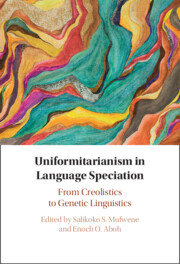Refine listing
Actions for selected content:
1295956 results in Books
6 - Puissance Absolue
-
- Book:
- Empire of Fear
- Published online:
- 27 November 2025
- Print publication:
- 11 December 2025, pp 234-269
-
- Chapter
- Export citation
Chapter 15 - Symbolic Conformation of Market Pricing
- from Part IV - Concrete Operations of One-to-One Correspondence for Equality Matching, Arbitrary Symbolism for Market Pricing, Combinations of Conformations, and What Children Discover
-
- Book:
- Representing Relationships
- Published online:
- 21 November 2025
- Print publication:
- 11 December 2025, pp 325-347
-
- Chapter
- Export citation
Chapter 5 - Ideas
- from Part I - Method, Metaphysics, and Epistemology
-
- Book:
- The Philosophy of Antoine Arnauld
- Published online:
- 27 November 2025
- Print publication:
- 11 December 2025, pp 91-117
-
- Chapter
- Export citation
Contents
-
- Book:
- Protecting Women
- Published online:
- 27 November 2025
- Print publication:
- 11 December 2025, pp vii-viii
-
- Chapter
- Export citation
17 - The Mid Century Canon
-
-
- Book:
- The Cambridge History of Australian Poetry
- Published online:
- 19 November 2025
- Print publication:
- 11 December 2025, pp 313-334
-
- Chapter
- Export citation
Copyright page
-
- Book:
- Kant and the Power of Perception
- Published online:
- 27 November 2025
- Print publication:
- 11 December 2025, pp iv-iv
-
- Chapter
- Export citation
11 - The New Woman and Poetry (1885–1935)
-
-
- Book:
- The Cambridge History of Australian Poetry
- Published online:
- 19 November 2025
- Print publication:
- 11 December 2025, pp 208-223
-
- Chapter
- Export citation

'The People' and British Literature
- Belonging, Exclusion, and Democracy
- Coming soon
-
- Expected online publication date:
- December 2025
- Print publication:
- 11 December 2025
-
- Book
- Export citation
Chapter 5 - Neurotransmitters and Neuromodulators in Dementia
- from Section 1 - Introductory Chapters on Dementia
-
-
- Book:
- The Behavioral Neurology of Dementia
- Published online:
- 17 November 2025
- Print publication:
- 11 December 2025, pp 75-86
-
- Chapter
- Export citation
Afterword
-
- Book:
- Irish Romanticism
- Published online:
- 27 November 2025
- Print publication:
- 11 December 2025, pp 164-181
-
- Chapter
- Export citation
Contents
-
- Book:
- Catalytic Capital
- Published online:
- 27 November 2025
- Print publication:
- 11 December 2025, pp v-vii
-
- Chapter
-
- You have access
- Open access
- HTML
- Export citation
Part I - Mobilizing Catalytic Finance
-
- Book:
- Catalytic Capital
- Published online:
- 27 November 2025
- Print publication:
- 11 December 2025, pp 21-112
-
- Chapter
-
- You have access
- Open access
- HTML
- Export citation
Chapter 8 - Mirroring through Intuition
-
- Book:
- Kant and the Power of Perception
- Published online:
- 27 November 2025
- Print publication:
- 11 December 2025, pp 246-270
-
- Chapter
- Export citation
Introduction
-
- Book:
- Kant and the Power of Perception
- Published online:
- 27 November 2025
- Print publication:
- 11 December 2025, pp 1-11
-
- Chapter
- Export citation
Chapter 13 - Expenditure on Consumption
- from Part III - Standards of Living
-
- Book:
- The Power of Peasant Consumers
- Published online:
- 27 November 2025
- Print publication:
- 11 December 2025, pp 265-281
-
- Chapter
- Export citation

Uniformitarianism in Language Speciation
- From Creolistics to Genetic Linguistics
- Coming soon
-
- Expected online publication date:
- December 2025
- Print publication:
- 18 December 2025
-
- Book
- Export citation
Acknowledgments
-
- Book:
- Protecting Women
- Published online:
- 27 November 2025
- Print publication:
- 11 December 2025, pp xiii-xvi
-
- Chapter
- Export citation
Acknowledgments
-
- Book:
- Rebuilding Histories in the Roman World
- Published online:
- 23 November 2025
- Print publication:
- 11 December 2025, pp xix-xxiii
-
- Chapter
- Export citation
Preface
-
- Book:
- Kant and the Power of Perception
- Published online:
- 27 November 2025
- Print publication:
- 11 December 2025, pp vii-viii
-
- Chapter
- Export citation
Index
-
- Book:
- Everyday Occupation
- Published online:
- 27 November 2025
- Print publication:
- 11 December 2025, pp 287-292
-
- Chapter
-
- You have access
- Open access
- HTML
- Export citation
